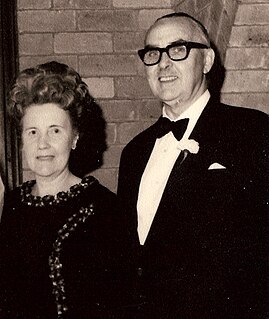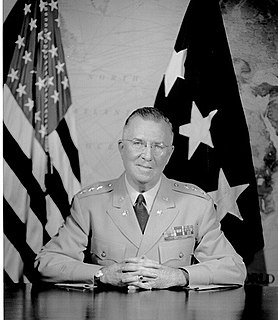
A proximity fuze is a fuze that detonates an explosive device automatically when the distance to the target becomes smaller than a predetermined value. Proximity fuzes are designed for targets such as planes, missiles, ships at sea, and ground forces. They provide a more sophisticated trigger mechanism than the common contact fuze or timed fuze. It is estimated that it increases the lethality by 5 to 10 times, compared to these other fuzes.

Joseph Oswald Mauborgne co-invented the one-time pad with Gilbert Vernam of Bell Labs. In 1914 he published the first recorded solution of the Playfair cipher. Mauborgne became a Major General in the United States Army, and from October 1937 to his retirement in 1941 was the Army's 12th Chief Signal Officer, in command of the Signal Corps.

The United States Army Signal Corps (USASC) is a branch of the United States Army that creates and manages communications and information systems for the command and control of combined arms forces. It was established in 1860, the brainchild of Major Albert J. Myer, and had an important role in the American Civil War. Over its history, it had the initial responsibility for portfolios and new technologies that were eventually transferred to other U.S. government entities. Such responsibilities included military intelligence, weather forecasting, and aviation.

Fort Monmouth is a former installation of the Department of the Army in Monmouth County, New Jersey. The post is surrounded by the communities of Eatontown, Tinton Falls and Oceanport, New Jersey, and is located about five miles (8.0 km) from the Atlantic Ocean. The post covers nearly 1,126 acres (4.56 km2) of land, from the Shrewsbury River on the east, to Route 35 on the west; this area is referred to as 'Main Post'. A separate area to the west includes post housing, a golf course, and additional office and laboratory facilities. A rail line, owned by Conrail, runs through Camp Charles Wood and out to Naval Weapons Station Earle. The post is like a small town, including a Post Exchange (PX), health clinic, gas station and other amenities. Until the September 11, 2001 terrorist attacks the post was open to the public to drive through; after that time, the post was closed to all but authorized personnel. The main road through the fort was reopened to the public in 2017.

Camp Evans Historic District is an area of the Camp Evans Formerly Used Defense Site in Wall Township, New Jersey. The site of the military installation is noted for a 1914 transatlantic radio receiver and various World War II/Cold War laboratories of the United States Army. It was designated a National Historic Landmark District in 2012, in recognition of the site's long role in the development of modern civilian and military electronic communications.

Walter Samuel McAfee was an American scientist and astronomer, notable for participating in the world's first lunar radar echo experiments with Project Diana.

Harry Clyde Ingles was a United States Army major general, who served during World War II and commanded the United States Army Signal Corps.

The Communications-Electronics Command (CECOM) is a Life Cycle Management Command (LCMC) of the United States Army based at Aberdeen Proving Ground, Maryland, United States. It is one of four such commands under the Army Materiel Command (AMC), and is the Army's provider and maintainer of Command, Control, Communications, Computers, Cyber, Intelligence, Surveillance and Reconnaissance (C5ISR) capabilities.
Signal Corps Laboratories (SCL) was formed on June 30, 1930, as part of the U.S. Army Signal Corps at Fort Monmouth, New Jersey. Through the years, the SCL had a number of changes in name, but remained the operation providing research and development services for the Signal Corps.
Harold Adelbert Zahl was an American physicist who had a 35-year career with the U.S. Army Signal Corps Laboratories, where he served as the director of research at Fort Monmouth and made major contributions to radar development. He is perhaps most famous for inventing the GA-4 Transmitter-Receiver Tube and the VT-158, which became known as the Zahl tube.

William Richards Blair was an American scientist and United States Army officer, who worked on the development of the radar from the 1930s onward. He led the U.S. Army's Signal Corps Laboratories during its formative years and is often called the "Father of American Radar".

William Alan Stewart Butement was a New Zealand-born British-Australian defence scientist and public servant. A native of New Zealand, he made extensive contributions to radar development in Great Britain during World War II, served as the first chief scientist for the Australian Defence Scientific Service, then ended his professional career with a research position in private business.
John William Marchetti was a radar pioneer who had an outstanding career combining government and industrial activities. He was born of immigrant parents in Boston, Massachusetts, and entered Columbia College and Columbia School of Engineering and Applied Science in 1925. In a six-year program combining liberal arts and engineering, he earned both A.B. and B.S. degrees, followed by the graduate E.E. degree in 1931. He was employed by New York Edison as a power engineer for several years, during which time he also participated in the U.S. Naval Reserve as an Ensign.

James Dunne O'Connell was a United States Army Lieutenant General who was noteworthy for serving as Chief of the United States Army Signal Corps.

Vaughn Olin Lang was a lieutenant general in the United States Army.

Thomas Matthew "Big Tom" Rienzi was a lieutenant general in the U.S. Army Signal Corps who served during World War II, the Korean War and Vietnam War. He implemented the modernization of signal units from the usage of just wire and radio, through the growth of strategic satellite communications, to the integration of computer systems at even the tactical level.

Emmett Paige Jr. served as the United States Assistant Secretary of Defense for Command, Control, Communications and Intelligence from 1993 to 1997. He retired from active duty in the United States Army as a lieutenant general in 1988 after 41 years of military service.
The Atmospheric Sciences Laboratory (ASL) was a research institution under the U.S. Army Materiel Command that specialized in artillery meteorology, electro-optical climatology, atmospheric optics data, and atmospheric characterization from 1965 to 1992. ASL was one of the seven Army laboratories that merged to form the U.S. Army Research Laboratory (ARL) in 1992.
The Electronics Technology and Devices Laboratory (ETDL) was a research institution located at Fort Monmouth, New Jersey that served as the U.S. Army's central laboratory for electronics research from 1971 to 1992. ETDL was one of the seven Army laboratories that merged to form the U.S. Army Research Laboratory (ARL).
The Vulnerability Assessment Laboratory (VAL) was a research institution under the U.S. Army Materiel Command (AMC) that specialized in missile electronic warfare, vulnerability, and surveillance. It was responsible for assessing the vulnerability of Army weapons and electronic communication systems to hostile electronic warfare and coordinating missile electronic countermeasure efforts for the U.S. Army. VAL was one of the seven Army laboratories that merged to form the U.S. Army Research Laboratory (ARL) in 1992.













